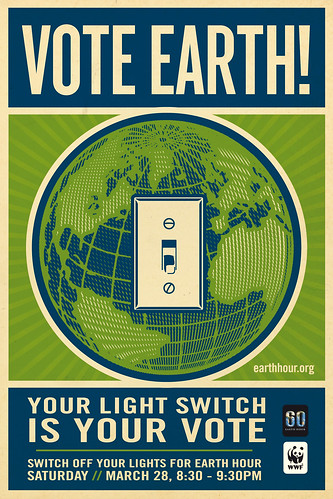
Earth Hour began in Sydney in 2007, when 2.2 million homes and businesses switched off their lights for one hour. This year, Earth Hour has been transformed into the world’s first global election, between Earth and global warming. In order to cast your vote for Planet Earth, you need to turn off your lights at the minimum between 8:30 PM and 9:30 PM today.
In December 2009, world leaders will meet at the Global Climate Change Conference in Denmark and discuss strategies that would replace the Kyoto Protocol. The WWF are trying to provide the results from today's "election" as evidence to the widespread urge across the world to take action against global warming.
While it is pretty straightforward to understand why WWF is promoting this effort, it may be worthwhile to examine the skepticism surrounding it.
1. Hour of no power will increase emissions:
Bjorn Lomborg, author of Cool It and The Skeptical Environmentalist argues that people resorting to candles during the Earth Hour will emit more carbon and pollute the air further, as candles are almost 100 times less efficient than incandescent light globes, and more than 300 times less efficient than fluorescent lights. If you use one candle for each extinguished globe, you're essentially not cutting CO2 at all, and with two candles you'll emit more CO2. Moreover, candles produce indoor air pollution 10 to 100 times the level of pollution caused by all cars, industry and electricity production.
There are some skeptics that say that the publicity done for the program will increase the emissions more than what can be saved in that one hour.
2. How can we measure the success of this effort?
This is not a controlled experiment, and it will not be possible to accurately determine the reduction in emissions or the number of people who participate in Earth Hour 2009.
However, there have been several efforts in progress to encourage people to measure their carbon footprint, so that individual lifestyle changes may have a positive impact on global emissions eventually. Ranging from online applications on Facebook that help track your footprint based on your lifestyle to workbooks that help monitor and control emissions based on your energy usage, there are plenty of resources you can tap into, if you're committed to making environment friendly decisions.
3. To-be or not to-be?
Many have been intrigued at the idea of measuring the impact of Earth Hour on emissions. If you're one of them, you'd be depressed to read this paper, which reports that individual lifestyle changes done during the Earth Hour are not effective in reducing emissions.
The Buddha said "Don't Mistake the Finger Pointing at the Moon for the Moon". It is important to recognize that this is a symbolic effort aimed at conveying a message. If more than a billion people across the world, from the Las Vegas strip to Sydney participate in an effort, it indisputably sends a message. Earth Hour is not poor symbolism, as long as it does not [and it will not] increase emissions drastically.
So, I will vote for Planet Earth, not by turning my lights off during that 1 hour, but through this post, for it is important that you and I recognize Earth Hour as the finger pointing at the moon, and send a message to our leaders that we need to act on global warming. From breathing to breezing through the street, everything we do emits carbon. It is not going to be easy to reduce emissions. Bjorn Lomborg argues in the same post, that "each nation should sign up to spend 0.05 per cent of its gross domestic product on low-carbon energy research and development. The total global cost would be 10 times greater than present spending, yet be 10 times less than the cost of the Kyoto Protocol on carbon emission reductions. This response to global warming is a realistic, achievable one."
Needless to say, there's many a mile between the finger and the Moon. Let the journey begin.



